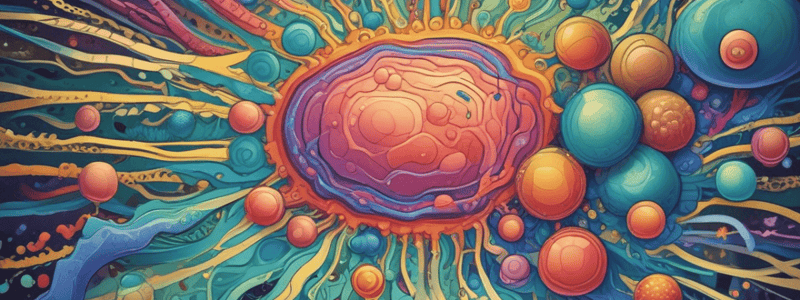Podcast
Questions and Answers
What is the characteristic of GLUT2 in terms of glucose uptake?
What is the characteristic of GLUT2 in terms of glucose uptake?
- Low Km and low Jmax
- High Km and low Jmax
- Low Km and high Jmax
- High Km and high Jmax (correct)
In which type of cells is GLUT3 primarily found?
In which type of cells is GLUT3 primarily found?
- Muscle cells
- Neurones (correct)
- Adipocytes
- Hepatocytes
What is the effect of insulin on GLUT4 in muscle and adipose cells?
What is the effect of insulin on GLUT4 in muscle and adipose cells?
- Insulin has no effect on GLUT4
- Insulin increases the amount of GLUT4 in the plasma membrane (correct)
- Insulin stimulates the degradation of GLUT4
- Insulin decreases the amount of GLUT4 in the plasma membrane
What is the primary function of ligand-gated ion channels?
What is the primary function of ligand-gated ion channels?
What is the characteristic of GLUT4 in terms of its Km?
What is the characteristic of GLUT4 in terms of its Km?
What is the location of GLUT4 in the absence of insulin?
What is the location of GLUT4 in the absence of insulin?
What is the primary characteristic of a membrane that allows it to be selective in regulating the passage of molecules?
What is the primary characteristic of a membrane that allows it to be selective in regulating the passage of molecules?
Which of the following molecules would be more likely to cross the membrane by simple diffusion?
Which of the following molecules would be more likely to cross the membrane by simple diffusion?
What is the name of the process by which solutes move down a concentration gradient across a membrane, but require a membrane protein (ion channel) to facilitate transport?
What is the name of the process by which solutes move down a concentration gradient across a membrane, but require a membrane protein (ion channel) to facilitate transport?
What is the term for the maximum rate of uptake of a solute by a transporter?
What is the term for the maximum rate of uptake of a solute by a transporter?
Which of the following is an example of a facilitated diffusion transporter?
Which of the following is an example of a facilitated diffusion transporter?
What is the name of the glucose transporter that has a high affinity for glucose, with a Km of approximately 1.8mM?
What is the name of the glucose transporter that has a high affinity for glucose, with a Km of approximately 1.8mM?
What is the primary function of the Na+/K+-ATPase membrane pump?
What is the primary function of the Na+/K+-ATPase membrane pump?
What is the term for the concentration of solute at which the rate of uptake is half the maximum rate?
What is the term for the concentration of solute at which the rate of uptake is half the maximum rate?
Which of the following types of transport requires the input of energy to move solutes across the membrane?
Which of the following types of transport requires the input of energy to move solutes across the membrane?
What is the term for the ability of a transporter to bind to a solute?
What is the term for the ability of a transporter to bind to a solute?
What is the primary function of the Na+/K+ pump in nerve transmission?
What is the primary function of the Na+/K+ pump in nerve transmission?
Which type of transport is facilitated by the Na+/K+ pump?
Which type of transport is facilitated by the Na+/K+ pump?
What is the role of the sodium-calcium exchanger in muscle cells?
What is the role of the sodium-calcium exchanger in muscle cells?
What is the effect of digitoxin on the Na+/K+ pump?
What is the effect of digitoxin on the Na+/K+ pump?
What is the type of transport facilitated by the Na+/glucose cotransporter (SGLUT)?
What is the type of transport facilitated by the Na+/glucose cotransporter (SGLUT)?
What is the function of the cystic fibrosis transmembrane conductance regulator protein (CFTR)?
What is the function of the cystic fibrosis transmembrane conductance regulator protein (CFTR)?
What is the effect of cholera toxin on the CFTR channel?
What is the effect of cholera toxin on the CFTR channel?
What is the role of the Na+ gradient in the uptake of glucose into cells via SGLUT?
What is the role of the Na+ gradient in the uptake of glucose into cells via SGLUT?
What is the type of transport facilitated by the GLUT protein?
What is the type of transport facilitated by the GLUT protein?
What is the effect of ouabain on the Na+/K+ pump?
What is the effect of ouabain on the Na+/K+ pump?
Flashcards are hidden until you start studying
Study Notes
Membrane Transport
- Membranes are selective permeability barriers, blocking the passage of almost all hydrophilic molecules into cells and organelles.
- Small uncharged or hydrophobic molecules can freely cross the membrane by simple diffusion along their concentration gradients.
- Charged polar molecules require specialist proteins (pumps, transporters, pores) to allow them to cross the membrane.
Molecules Crossing Membranes
- Lipid bilayer permeability is higher for molecules that are uncharged, non-polar, and small.
- Examples of molecules that can cross the membrane:
- Hydrophobic molecules: O2, N2, CO2, benzene, short chain fatty acids.
- Small uncharged polar molecules: H2O, urea, glycerol.
- Large uncharged polar molecules: glucose, sucrose.
- Ions: H+, Na+, Mg2+, HCO3-, K+, Ca2+, Cl-.
- Charged polar molecules: amino acids, ATP.
Mechanisms of Transport
- Simple passive transport / Diffusion: solutes move down a concentration gradient, crossing the membrane.
- Facilitated diffusion: solutes move down a concentration gradient, crossing the membrane, requiring a membrane protein (ion channel).
- Gated ion channels: allow facilitated diffusion, selective for different ions, and open or close in response to a stimulus.
- Primary active transport: solutes move against a concentration gradient, requiring a membrane protein and energy from ATP hydrolysis.
- Secondary active transport: uses a pre-established gradient to drive transport of solutes across the membrane against a gradient.
Passive Transport
- Solutes move down a concentration gradient, crossing the membrane, at equilibrium [inside cell] = [outside cell].
- Rate of diffusion depends on the Partition Coefficient of the solute.
- Solutes that are more hydrophobic have a higher Partition Coefficient and equilibrate more quickly.
Facilitated Diffusion
- Solutes move down a concentration gradient, crossing the membrane, at equilibrium [inside cell] = [outside cell].
- Requires a membrane protein (ion channel).
- Examples:
- Cl-/HCO3- channel in erythrocytes.
- Aquaporin: water channel.
- GLUT glucose transporters.
Transporter Affinity
- Transporter affinity for solutes is given by the Km (Michaelis constant).
- The lower the Km, the higher the affinity.
GLUT (Glucose Transporter) Family
- Mediates constitutive glucose uptake in many tissues.
- Examples:
- GLUT1: ubiquitous, low Km (high affinity), abundant in erythrocytes and low in skeletal muscle.
- GLUT2: liver, pancreatic ß-cells, high Km (low affinity) and large Jmax (high capacity).
- GLUT3: neurons, low Km (high affinity).
- GLUT4: muscle, adipocytes, Km similar to fed state blood glucose concentration, regulated by insulin.
Insulin and GLUT4
- Insulin stimulates uptake of glucose in muscle and adipose tissue.
- Insulin increases the amount of GLUT4 in the plasma membrane.
- GLUT4 is present on membrane-bound vesicles in the cytoplasm.
- Insulin triggers the movement of vesicles to the plasma membrane, increasing the level of GLUT4 on the cell surface.
- Increased glucose transporters increase the uptake of glucose into the cell.
Gated Ion Channels
- Ion channels that allow facilitated diffusion, selective for different ions.
- Examples:
- Ligand-gated: e.g., acetylcholine and acetylcholine-gated Na+/K+ channel.
- Voltage-gated: e.g., Na+ and K+ channels in axons involved in nerve transduction.
Active Transport
- Solutes move against a concentration gradient, requiring a membrane protein and energy from ATP hydrolysis.
- Examples:
- Na+/K+ pump (Na+/K+ ATPase) in the plasma membrane.
- Part of co-transport systems to drive solute movement.
Na+/K+ Pump
- Consists of a tetramer (α2β2).
- Na+ enters the open cytoplasmic access, and phosphorylation from ATP at the cytoplasmic site causes a conformational change.
- Conformational change closes the cytoplasmic access and opens the external access.
- Conformational change means that the pump binds K+ and releases Na+ outside the cell.
- Hydrolysis of the phosphate group closes the external access, opens the cytoplasmic access, and releases K+ into the cell.
Co-Transport Systems
- Pre-established gradient is used to drive transport of solutes across the membrane against a gradient.
- ATP hydrolysis is used to establish the primary gradient.
- Examples:
- Symport: transport of two solutes in the same direction.
- Antiport: transport of two solutes in opposite directions.
Na+/Glucose Cotransporter (SGLUT)
- Glucose absorption from the intestine against a gradient.
- SGLUT is a symport.
- Na+ gradient established by the Na+/K+ pump and ATP hydrolysis is used to drive the uptake of glucose into cells.
- Secondary active transport.
Clinical Considerations
- Digitoxin: cardiac glycosides that inhibit the Na+/K+ pump, increasing [Na+] inside heart muscle and contraction.
- Ouabain: cardiac glycosides that inhibit the Na+/K+ pump, increasing [Na+] inside heart muscle and contraction.
- CFTR (Cystic Fibrosis Transmembrane Conductance Regulator): a chloride ion channel in cells responsible for producing mucus, sweat, saliva, and tears.
- Cholera toxin: stimulates an increase in cAMP level, activating CFTR and secretion of chloride ions, followed by Na+ and water into the lumen of the gut.
- Oral rehydration therapy: includes high glucose concentration to drive Na+ uptake into cells via SGLUT, treating cholera.
Studying That Suits You
Use AI to generate personalized quizzes and flashcards to suit your learning preferences.




